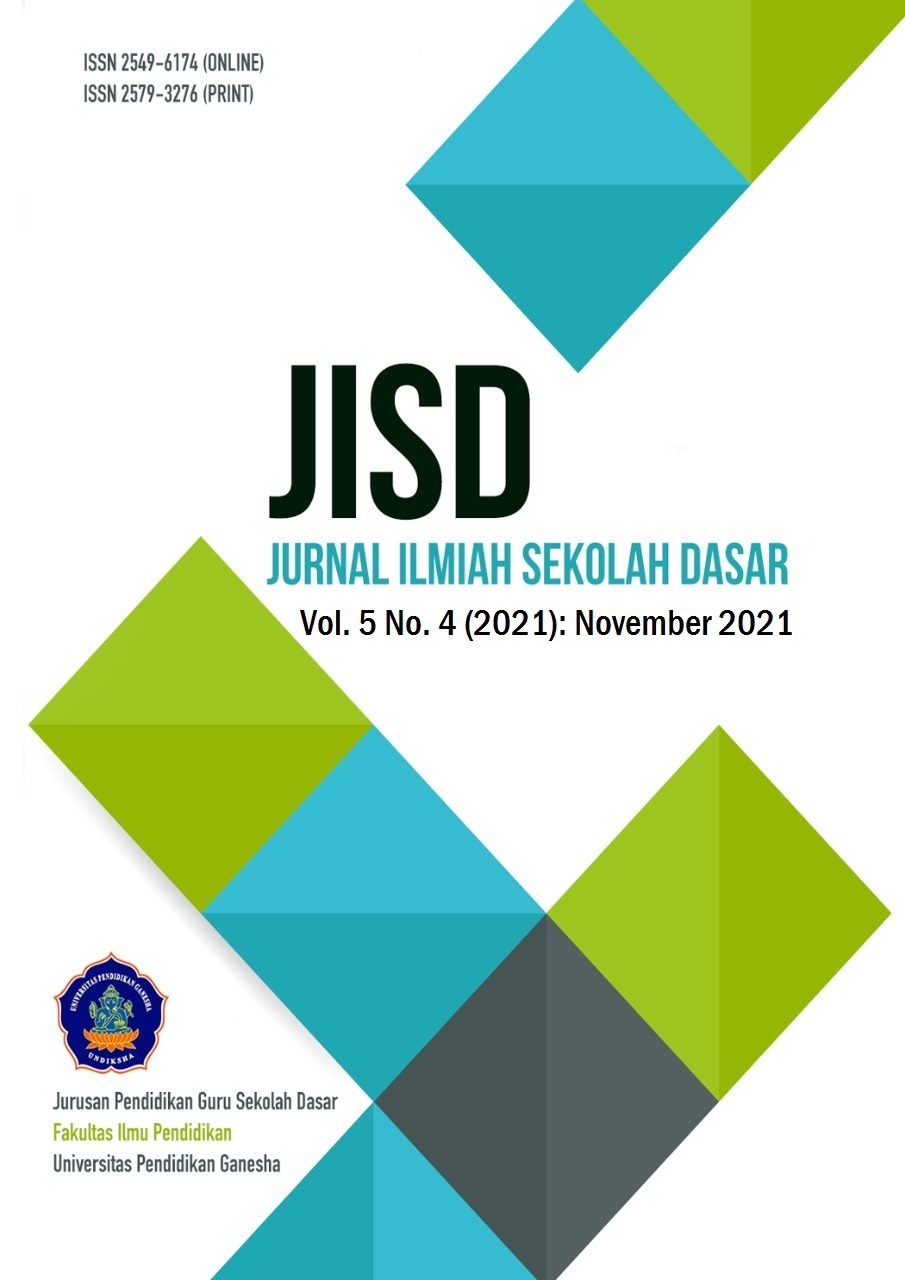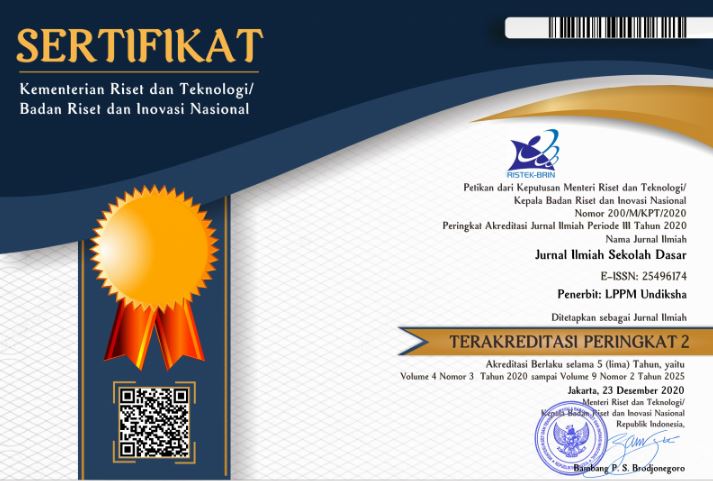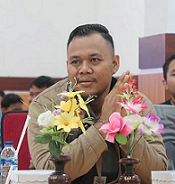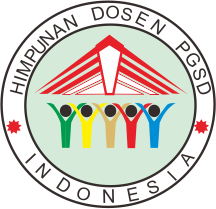Math Creativity Survey For Class 4 Elementary School
DOI:
https://doi.org/10.23887/jisd.v5i4.39479Keywords:
Creativity, Mathematics, Elementary SchoolAbstract
Problems in mathematics are increasingly complicated, especially related to students' creativity. The fundamental problem of learning mathematics is that learning is difficult and tedious and impacts students' learning outcomes. It needs special attention so that students' creative abilities in mathematics must be developed in various ways. The purpose of this study is to analyze the creativity of elementary school students in learning Mathematics. This research uses a descriptive approach in the form of a survey. This study involved 200 students from 11 elementary schools. The research instrument is a questionnaire based on four aspects: flexibility, originality, and elaboration. A descriptive approach was used to analyze the research data. The findings show that students' creativity differs in four aspects. The Fluency Aspect got a score of 3.07 in the medium category. The flexibility aspect got a score of 3,098 in the medium category. The originality aspect got a score of 2.37 in the medium category. The aspect elaboration got a score of 2.47 in the medium category. Based on the study results, it can be found that from the four aspects of student creativity in the medium category. The findings state that sub-indicators in every aspect of creativity need to be developed and improved.
References
Agustika, G. N. S., Kartika, A. A. W., & Wiarta, I. W. (2019). Efektivitas Model Pembelajaran Kooperatif Tipe Pair Checks Ditinjau dari Kecerdasan Interpersonal terhadap Kompetensi Pengetahuan Matematika. Jurnal Ilmiah Sekolah Dasar, 3(3), 297. https://doi.org/10.23887/jisd.v3i3.19454. DOI: https://doi.org/10.23887/jisd.v3i3.19454
Al Fatta, H., Maksom, Z., & Zakaria, M. H. (2018). Systematic literature review on usability evaluation model of educational games: Playability, pedagogy, and mobility aspects. Journal of Theoretical and Applied Information Technology, 96(14), 4677–4689.
Aqda, M. F., Hamidi, F., & Rahimi, M. (2011). The comparative effect of computer-aided instruction and traditional teaching on student’s creativity in math classes. Procedia Computer Science, 3, 266–270. https://doi.org/10.1016/j.procs.2010.12.045. DOI: https://doi.org/10.1016/j.procs.2010.12.045
Ayalon, M., & Wilkie, K. J. (2020). Developing assessment literacy through approximations of practice: Exploring secondary mathematics pre-service teachers developing criteria for a rich quadratics task. Teaching and Teacher Education, 89, 103011. https://doi.org/10.1016/j.tate.2019.103011. DOI: https://doi.org/10.1016/j.tate.2019.103011
Ayvaz, Ü., & Durmuş, S. (2021). Fostering mathematical creativity with problem posing activities: An action research with gifted students. Thinking Skills and Creativity, 40(February). https://doi.org/10.1016/j.tsc.2021.100846. DOI: https://doi.org/10.1016/j.tsc.2021.100846
Baciu, D. C. (2021). Creativity and diversification: What digital systems teach. Thinking Skills and Creativity, 41(April), 100885. https://doi.org/10.1016/j.tsc.2021.100885. DOI: https://doi.org/10.1016/j.tsc.2021.100885
Bahar, A., & Ozturk, M. A. (2018). An Exploratory Study on the Relationship between Creativity and Processing Speed for Gifted Children. International Education Studies, 11(3), 77. https://doi.org/10.5539/ies.v11n3p77. DOI: https://doi.org/10.5539/ies.v11n3p77
Bereczki, E. O., & Kárpáti, A. (2021). Technology-enhanced creativity: A multiple case study of digital technology-integration expert teachers’ beliefs and practices. Thinking Skills and Creativity, 39(November 2020). https://doi.org/10.1016/j.tsc.2021.100791. DOI: https://doi.org/10.1016/j.tsc.2021.100791
Bicer, A., Marquez, A., Colindres, K. V. M., Schanke, A. A., Castellon, L. B., Audette, L. M., … Lee, Y. (2021). Investigating creativity-directed tasks in middle school mathematics curricula. Thinking Skills and Creativity, 40(March), 100823. https://doi.org/10.1016/j.tsc.2021.100823. DOI: https://doi.org/10.1016/j.tsc.2021.100823
Bruce, C. D., Flynn, T. C., & Bennett, S. (2016). A focus on exploratory tasks in lesson study: The Canadian ‘Math for Young Children’ project. ZDM - Mathematics Education, 48(4), 541–554. https://doi.org/10.1007/s11858-015-0747-7. DOI: https://doi.org/10.1007/s11858-015-0747-7
Corazza, G. E. (2016). Potential Originality and Effectiveness: The Dynamic Definition of Creativity. Creativity Research Journal, 28(3), 258–267. https://doi.org/10.1080/10400419.2016.1195627. DOI: https://doi.org/10.1080/10400419.2016.1195627
Demirtaş, B., & Batdal Karaduman, G. (2021). Adaptation of the SenSel creativity-sensitization and self questionnaire for educators and teachers into Turkish and its relationship with mathematical thinking skills. Thinking Skills and Creativity, 39(January). https://doi.org/10.1016/j.tsc.2021.100790. DOI: https://doi.org/10.1016/j.tsc.2021.100790
Dietrich, A. (2019). Types of creativity. Psychonomic Bulletin and Review, 26(1). https://doi.org/10.3758/s13423-018-1517-7. DOI: https://doi.org/10.3758/s13423-018-1517-7
Fajriah, N., & Asiskawati, E. (2015). Kemampuan Berpikir Kreatif Siswa dalam Pembelajaran Matematika Menggunakan Pendekatan Pendidikan Matematika Realistik di SMP. EDU-MAT: Jurnal Pendidikan Matematika, 3(2), 157–165. https://doi.org/10.20527/edumat.v3i2.643. DOI: https://doi.org/10.20527/edumat.v3i2.643
Fernández-Fontecha, A. (2021). The role of learner creativity in L2 semantic fluency. An exploratory study. System, 103(October), 102658. https://doi.org/10.1016/j.system.2021.102658. DOI: https://doi.org/10.1016/j.system.2021.102658
Ginns, P., Freebody, K., Anderson, M., & O’Connor, P. (2021). Student experience of creativity in Australian high school classrooms: A componential model. Learning and Individual Differences, 91(August), 102057. https://doi.org/10.1016/j.lindif.2021.102057. DOI: https://doi.org/10.1016/j.lindif.2021.102057
Gita Cemara, G. A., & Sudana, D. N. (2019). Pengaruh Model Pembelajaran SAVI Bermuatan Peta Pikiran Terhadap Kreativitas dan Penguasaan Kompetensi Pengetahuan IPA Siswa. Jurnal Ilmiah Sekolah Dasar, 3(3), 359. https://doi.org/10.23887/jisd.v3i3.18895. DOI: https://doi.org/10.23887/jisd.v3i3.18895
Gralewski, J., & Karwowski, M. (2019). Are teachers’ ratings of students’ creativity related to students’ divergent thinking? A meta-analysis. Thinking Skills and Creativity, 33(February 2018), 100583. https://doi.org/10.1016/j.tsc.2019.100583. DOI: https://doi.org/10.1016/j.tsc.2019.100583
Guo, J., Marsh, H. W., Parker, P. D., & Dicke, T. (2018). Cross-cultural generalizability of social and dimensional comparison effects on reading, math, and science self-concepts for primary school students using the combined PIRLS and TIMSS data. Learning and Instruction, 58(July), 210–219. https://doi.org/10.1016/j.learninstruc.2018.07.007. DOI: https://doi.org/10.1016/j.learninstruc.2018.07.007
Hidajat, A. F., Sa’dijah, C., Susiswo, S., Sudirman, S., & Asari, A. . (2018). Mathematical Creative Thinking Leveling on Non-Mathematics Department Students. Jurnal Pendidikan Sains, 6(1), 11–15. Retrieved from http://journal.um.ac.id/index.php/jps/.
Huang, P. S., Peng, S. L., Chen, H. C., Tseng, L. C., & Hsu, L. C. (2017). The relative influences of domain knowledge and domain-general divergent thinking on scientific creativity and mathematical creativity. Thinking Skills and Creativity, 25, 1–9. https://doi.org/10.1016/j.tsc.2017.06.001. DOI: https://doi.org/10.1016/j.tsc.2017.06.001
Huang, X., Chin-Hsi, L., Mingyao, S., & Peng, X. (2021). What drives teaching for creativity? Dynamic componential modelling of the school environment, teacher enthusiasm, and metacognition. Teaching and Teacher Education, 107, 103491. https://doi.org/10.1016/j.tate.2021.103491. DOI: https://doi.org/10.1016/j.tate.2021.103491
Kandemir, M. A., & Gür, H. (2009). The use of creative problem solving scenarios in mathematics education: views of some prospective teachers. Procedia - Social and Behavioral Sciences, 1(1), 1628–1635. https://doi.org/10.1016/j.sbspro.2009.01.286. DOI: https://doi.org/10.1016/j.sbspro.2009.01.286
Kasirer, A., & Shnitzer-Meirovich, S. (2021). The perception of creativity and creative abilities among general education and special education teachers. Thinking Skills and Creativity, 40(December 2020), 100820. https://doi.org/10.1016/j.tsc.2021.100820. DOI: https://doi.org/10.1016/j.tsc.2021.100820
Katz-Buonincontro, J., Perignat, E., & Hass, R. W. (2020). Conflicted epistemic beliefs about teaching for creativity. Thinking Skills and Creativity, 36(January), 100651. https://doi.org/10.1016/j.tsc.2020.100651. DOI: https://doi.org/10.1016/j.tsc.2020.100651
Kim, M. K., Roh, I. S., & Cho, M. K. (2016). Creativity of gifted students in an integrated math-science instruction. Thinking Skills and Creativity, 19, 38–48. https://doi.org/10.1016/j.tsc.2015.07.004. DOI: https://doi.org/10.1016/j.tsc.2015.07.004
Kirisci, N., Sak, U., & Karabacak, F. (2020). The effectiveness of the selective problem solving model on students’ mathematical creativity: A Solomon four-group research. Thinking Skills and Creativity, 38(May), 100719. https://doi.org/10.1016/j.tsc.2020.100719. DOI: https://doi.org/10.1016/j.tsc.2020.100719
Kozlowski, J. S., & Si, S. (2019). Mathematical creativity: A vehicle to foster equity. Thinking Skills and Creativity, 33(March). https://doi.org/10.1016/j.tsc.2019.100579. DOI: https://doi.org/10.1016/j.tsc.2019.100579
Lasky, D., & Yoon, S. (2020). A creative classroom for everyone: An introduction to a small ‘c’ creativity framework. Thinking Skills and Creativity, 36(July 2019), 100660. https://doi.org/10.1016/j.tsc.2020.100660. DOI: https://doi.org/10.1016/j.tsc.2020.100660
Lee, J., & Stankov, L. (2018). Non-cognitive predictors of academic achievement: Evidence from TIMSS and PISA. Learning and Individual Differences, 65(May), 50–64. https://doi.org/10.1016/j.lindif.2018.05.009. DOI: https://doi.org/10.1016/j.lindif.2018.05.009
Leikin, R., & Elgrably, H. (2020). Problem posing through investigations for the development and evaluation of proof-related skills and creativity skills of prospective high school mathematics teachers. International Journal of Educational Research, 102(July 2018), 1–13. https://doi.org/10.1016/j.ijer.2019.04.002. DOI: https://doi.org/10.1016/j.ijer.2019.04.002
Maharani, H. R. (2014). CREATIVE THINKING IN MATHEMATICS : ARE WE ABLE TO SOLVE MATHEMATICAL PROBLEMS IN A VARIETY OF WAY ? Hevy Risqi Maharani Sultan Agung Islamic University Semarang , Indonesia Csikszentmihalyi ( 1997 ) define c reative thinking is generating new ideas within. International Conference on Mathematics, Science, and Education 2014, 2014(Icmse).
Montag-Smit, T., & Maertz, C. P. (2017). Searching outside the box in creative problem solving: The role of creative thinking skills and domain knowledge. Journal of Business Research, 81(July), 1–10. https://doi.org/10.1016/j.jbusres.2017.07.021. DOI: https://doi.org/10.1016/j.jbusres.2017.07.021
Moore-Russo, D., & Demler, E. L. (2018). Linking Mathematical Creativity to Problem Solving: Views from the Field, 321–345. https://doi.org/10.1007/978-3-319-99861-9_14. DOI: https://doi.org/10.1007/978-3-319-99861-9_14
Mukhlis, M., & Tohir, M. (2019). Instrumen Pengukur Creativity And Innovation Mathematic Skills Mahasiswa pada. Indonesian Journal Of Mathematics and Natural Science Education, 1(2), 65–73. DOI: https://doi.org/10.35719/mass.v1i1.1
Nadjafikhah, M., & Yaftian, N. (2013). The Frontage of Creativity and Mathematical Creativity. Procedia - Social and Behavioral Sciences, 90(InCULT 2012), 344–350. https://doi.org/10.1016/j.sbspro.2013.07.101. DOI: https://doi.org/10.1016/j.sbspro.2013.07.101
Novak-Leonard, J. L., Skaggs, R., & Robinson, M. (2021). Innovative and artistic: Conceptions of creativity among the American public. Poetics, (July), 101599. https://doi.org/10.1016/j.poetic.2021.101599. DOI: https://doi.org/10.1016/j.poetic.2021.101599
Pulgar, J. (2021). Classroom creativity and students’ social networks: Theoretical and practical implications. Thinking Skills and Creativity, 42(December 2020), 100942. https://doi.org/10.1016/j.tsc.2021.100942. DOI: https://doi.org/10.1016/j.tsc.2021.100942
Rahmani, W., & Widyasari, N. (2017). Meningkatkan Kemampuan Berpikir Kreatif Matematis Siswa Melalui Media Tangram. Holistika Jurnal Ilmiah PGSD, 1(2), 131–136. DOI: https://doi.org/10.24853/fbc.4.1.17-23
Regier, P., & Savic, M. (2020). How teaching to foster mathematical creativity may impact student self-efficacy for proving. Journal of Mathematical Behavior, 57(September 2018), 100720. https://doi.org/10.1016/j.jmathb.2019.100720. DOI: https://doi.org/10.1016/j.jmathb.2019.100720
Schoevers, E. M., Leseman, P. P. M., Slot, E. M., Bakker, A., Keijzer, R., & Kroesbergen, E. H. (2019). Promoting pupils’ creative thinking in primary school mathematics: A case study. Thinking Skills and Creativity, 31(December 2018), 323–334. https://doi.org/10.1016/j.tsc.2019.02.003. DOI: https://doi.org/10.1016/j.tsc.2019.02.003
Sebastian, J., & Huang, H. (2016). Examining the relationship of a survey based measure of math creativity with math achievement: Cross-national evidence from PISA 2012. International Journal of Educational Research, 80, 74–92. https://doi.org/10.1016/j.ijer.2016.08.010. DOI: https://doi.org/10.1016/j.ijer.2016.08.010
Soh, K. (2017). Fostering student creativity through teacher behaviors. Thinking Skills and Creativity, 23, 58–66. https://doi.org/10.1016/j.tsc.2016.11.002. DOI: https://doi.org/10.1016/j.tsc.2016.11.002
Stolte, M., Kroesbergen, E. H., & Van Luit, J. E. H. (2019). Inhibition, friend or foe? Cognitive inhibition as a moderator between mathematical ability and mathematical creativity in primary school students. Personality and Individual Differences, 142(June), 196–201. https://doi.org/10.1016/j.paid.2018.08.024. DOI: https://doi.org/10.1016/j.paid.2018.08.024
Thuneberg, H. M., Salmi, H. S., & Bogner, F. X. (2018). How creativity, autonomy and visual reasoning contribute to cognitive learning in a STEAM hands-on inquiry-based math module. Thinking Skills and Creativity, 29(April), 153–160. https://doi.org/10.1016/j.tsc.2018.07.003. DOI: https://doi.org/10.1016/j.tsc.2018.07.003
Tubb, A. L., Cropley, D. H., Marrone, R. L., Patston, T., & Kaufman, J. C. (2020). The development of mathematical creativity across high school: Increasing, decreasing, or both? Thinking Skills and Creativity, 35(February), 100634. https://doi.org/10.1016/j.tsc.2020.100634. DOI: https://doi.org/10.1016/j.tsc.2020.100634
Ulrich, F., & Nielsen, P. A. (2020). Chaos and creativity in dynamic idea evaluation: Theorizing the organization of problem-based portfolios. Creativity and Innovation Management, 29(4), 566–580. https://doi.org/10.1111/caim.12400. DOI: https://doi.org/10.1111/caim.12400
Utari, D. R., Wardana, M. Y. S., & Damayani, A. T. (2019). Analisis Kesulitan Belajar Matematika dalam Menyelesaikan Soal Cerita. Jurnal Ilmiah Sekolah Dasar, 3(4), 545. https://doi.org/10.23887/jisd.v3i4.22311. DOI: https://doi.org/10.23887/jisd.v3i4.22311
Wulandari, N. P. R., Dantes, N., & Antara, P. A. (2020). Pendekatan Pendidikan Matematika Realistik Berbasis Open Ended Terhadap Kemampuan Pemecahan Masalah Matematika Siswa. Jurnal Ilmiah Sekolah Dasar, 4(2), 131. https://doi.org/10.23887/jisd.v4i2.25103. DOI: https://doi.org/10.23887/jisd.v4i2.25103
Zhou, Q. (2021). Development of creative thinking skills through aesthetic creativity in middle school educational music course. Thinking Skills and Creativity, 40(February), 100825. https://doi.org/10.1016/j.tsc.2021.100825. DOI: https://doi.org/10.1016/j.tsc.2021.100825
Downloads
Published
How to Cite
Issue
Section
License
Authors who publish with the Journal Ilmiah Sekolah Dasar agree to the following terms:
- Authors retain copyright and grant the journal the right of first publication with the work simultaneously licensed under a Creative Commons Attribution License (CC BY-SA 4.0) that allows others to share the work with an acknowledgment of the work's authorship and initial publication in this journal.
- Authors are able to enter into separate, additional contractual arrangements for the non-exclusive distribution of the journal's published version of the work (e.g., post it to an institutional repository or publish it in a book), with an acknowledgment of its initial publication in this journal.
- Authors are permitted and encouraged to post their work online (e.g., in institutional repositories or on their website) prior to and during the submission process, as it can lead to productive exchanges, as well as earlier and greater citation of published work. (See The Effect of Open Access)











